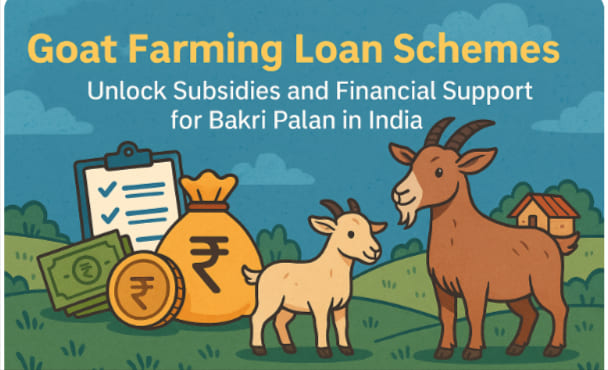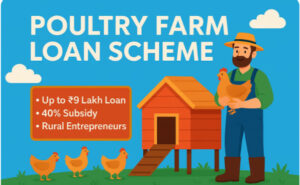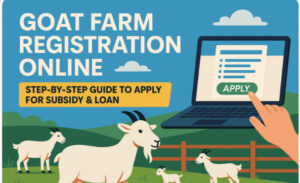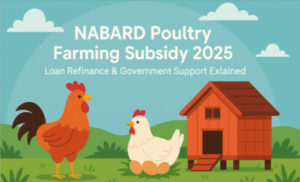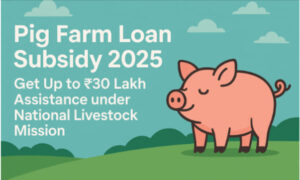Goat farming, or Bakri Palan, has emerged as a promising livelihood for small-scale farmers and rural entrepreneurs across India. With rising demand for goat meat, milk, and fiber, the sector is poised for significant growth in 2025. To support this, the Indian government and financial institutions offer various goat farming loan schemes and subsidies that can help farmers scale their businesses efficiently.
This article explores the top goat farming loan schemes available in 2025, highlights eligibility criteria, and offers guidance on securing subsidies under programs like NABARD, making it easier for you to navigate the process and maximize your benefits.
Why Choose Goat Farming in 2025?
- Low investment, high return: Goats are hardy, multiply quickly, and require less space compared to larger livestock.
- Market demand: Urban and rural demand for goat meat and milk continues to rise.
- Government support: New schemes and subsidies make goat farming a more viable and secure enterprise.
Top Goat Farming Loan Schemes 2025
-
NABARD Goat Farming Scheme
The National Bank for Agriculture and Rural Development (NABARD) continues to be a key player in financing goat farming in India. Through its refinance scheme, farmers can avail of loans via commercial, cooperative, and rural banks.
- Loan coverage: Purchase of goats, shed construction, feed, and veterinary care.
- Subsidy: 25–33% subsidy under the NABARD-backed Capital Investment Subsidy Scheme (CISS) for eligible farmers.
- Eligibility: Small/marginal farmers, SHGs, JLGs, and NGOs.
-
State-Specific Livestock Development Schemes
Many states offer additional incentives for goat farming:
- Maharashtra: Goats are supplied at subsidized rates through state livestock programs.
- Tamil Nadu: Subsidized loans for women-led self-help groups.
- Uttar Pradesh: Special grants for backward regions.
Check with local animal husbandry departments for details.
-
Mudra Yojana for Goat Farming
Under the Pradhan Mantri Mudra Yojana (PMMY), micro-enterprises, including goat farming, can access loans up to ₹10 lakh without collateral.
- Categories: Shishu, Kishore, Tarun — based on the business stage.
- Interest rates: Bank-specific, typically 8–12%.
-
Dairy Entrepreneurship Development Scheme (DEDS)
While primarily aimed at dairy farming, certain components cover goat milk production units and processing, offering further financial support.
Steps to Apply for a Goat Farming Loan
- Prepare a project report: Include details on herd size, infrastructure, costs, expected returns, and marketing plans.
- Choose the right bank: Approach nationalized banks, cooperative banks, or rural banks familiar with livestock financing.
- Submit necessary documents: Aadhaar, land ownership/lease papers, income proof, and the project report.
- Follow up: Stay in touch with the loan officer to track application progress.
Eligibility Criteria
- Small and marginal farmers — Those with limited landholdings, often below 2 hectares.
- Individual entrepreneurs — Including first-time farmers or rural youth wanting to start goat farming.
- Self-Help Groups (SHGs) and Joint Liability Groups (JLGs) — Groups of farmers or women’s groups working together.
- Cooperatives and NGOs — Registered organizations involved in livestock development.
- Existing goat farmers looking to expand — Those with a prior track record in livestock management.
- SC/ST, women, and minority beneficiaries — Often prioritized under government schemes for special subsidies.
Documents Required for Goat Farming Loans
- Loan application form (filled and signed)
- Goat farming project report — Includes herd size, cost estimate, expected profits, and marketing plan.
- Identity proof — Aadhaar Card, PAN Card, Voter ID, or Passport
- Address proof — Electricity bill, ration card, or Aadhaar
- Land ownership/lease papers — For farm location (if applicable)
- Income proof — Bank statements, income certificate, or ITR (if asked)
- Caste certificate — For SC/ST/OBC beneficiaries (if claiming special subsidy)
- Photographs — Passport-sized, typically 2–4 copies
- Bank account details — Passbook copy or account statement
Tips to Maximize Subsidies and Benefits
- Stay updated with state-level announcements.
- Join SHGs or cooperative groups for better loan eligibility.
- Attend government livestock training programs to enhance your profile.
- Keep proper records to ensure smooth subsidy disbursement.
Conclusion
Goat farming in India offers immense potential in 2025, thanks to robust demand and expanded government support. By leveraging loan schemes and subsidies wisely, farmers can build profitable and sustainable goat farming enterprises. For those ready to embark on their Bakri Palan journey, now is the perfect time to take advantage of these financial opportunities.
